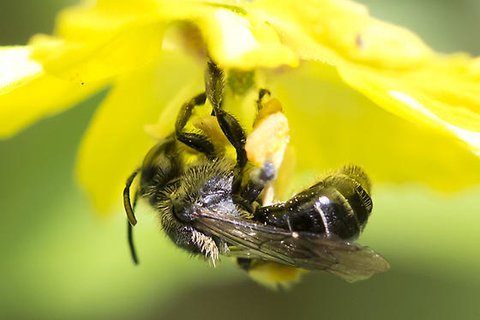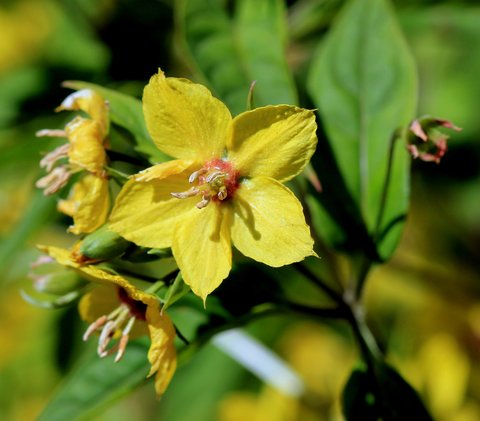Appearance
Many people know that bees rely on pollen and nectar from flowers, but some bees also depend on floral oils! A unique feature of oil-collecting bees is the spongey hairs they have on their back legs to collect floral oils. In Minnesota, we have several species of oil-collecting bee belonging to the genus Macropis. Macropis are medium-sized (about 7 mm long) shiny black to dark brown bees with long white hair on their back legs below the knee.
Where and when do you find them
To find Macropis, you first need to find yellow loosestrife (Lysimachia), a plant that grows near wetlands and flowers in June and July. Male and females collect nectar from many different flowers, but Macropis depend completely on the plant oils and pollen they collect from yellow loosestrife flowers to feed their young. The adults are primarily active from June to July, the same time that yellow loosestrife flowers bloom.
What is their life cycle?
Macropis have one generation per year. They nest in the soil. The mother bee mixes floral oils and pollen from yellow loosestrife flowers into a ball on which she lays an egg. The egg hatches and the larva eats the pollen and oil mix. After about a month, the larva becomes a pupa and remains in the nest underground until emerging as an adult and leaving the nest the next summer.
Importance to Minnesotans
Macropis are so rarely seen that it is difficult to protect them and make sure that we keep them from becoming extinct. Add oil-producing yellow loosestrife flowers to your flower garden, watch their flowers, and share photos of bees you see on the flowers on iNaturalist.org to help us keep track oil-collecting bee populations.
Fun fact
One of the rarest bees in North America is a species of bee that parasitizes Macropis. In the last 60 years, less than a dozen specimens of the Macropis Cuckoo Bee, Epeoloides pilosulus, have been collected anywhere. They have been found recently in Wisconsin and Michigan, but we have yet to document any in Minnesota.
For more information
Author
- Elaine Evans
Photo credit
- Joel Gardner (first photo)
- Karlej (second photo)



